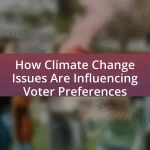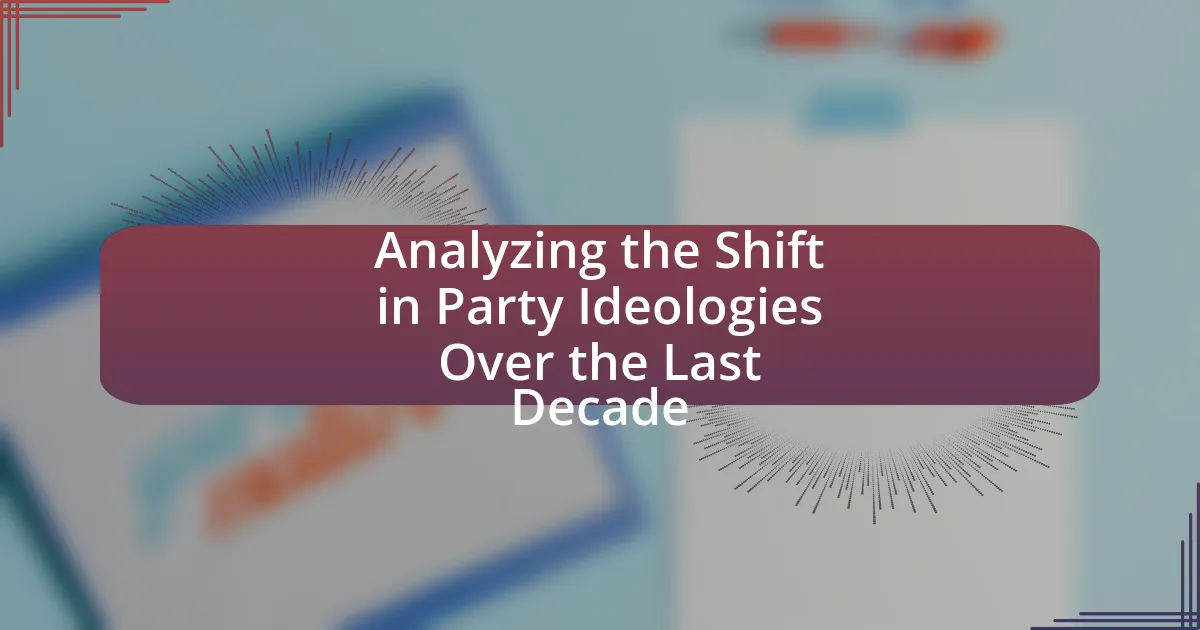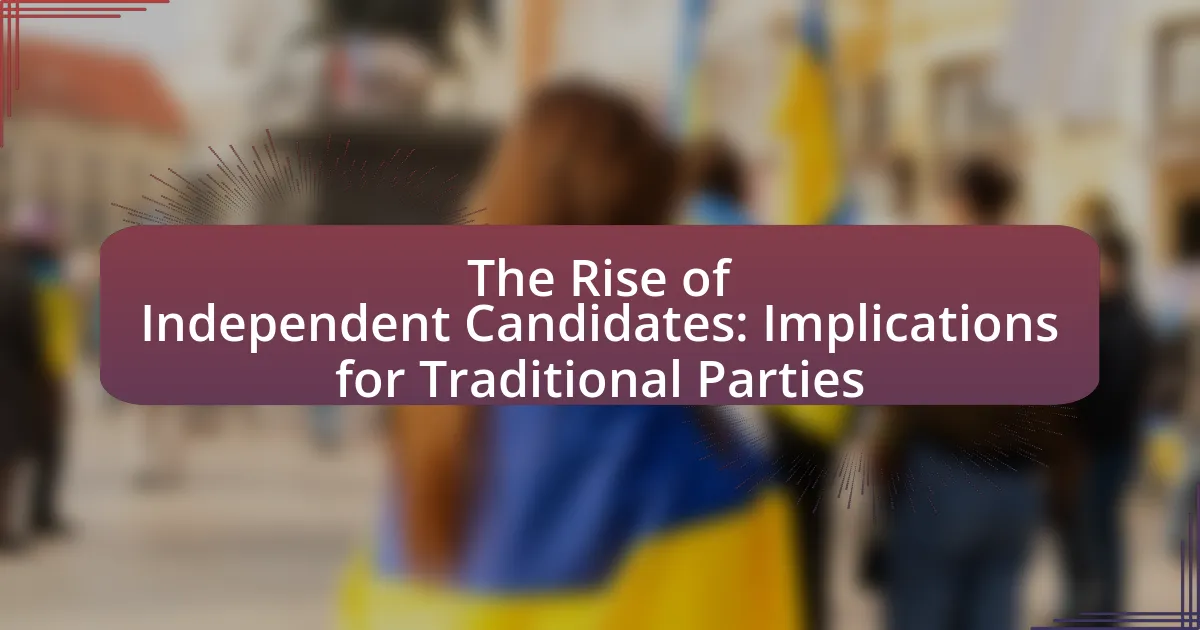The article examines the critical role of media coverage in shaping election narratives and influencing public perception during electoral processes. It highlights how selective reporting, framing, and agenda-setting by media outlets can sway voter opinions and priorities, ultimately affecting electoral outcomes. Key elements discussed include the impact of different media formats, the significance of media narratives on voter engagement and turnout, and the potential biases present in media coverage. Historical examples illustrate the transformative power of media in elections, while strategies employed by candidates to leverage media coverage are also explored. The article emphasizes the importance of critical evaluation of media sources for voters to navigate the complex landscape of election narratives effectively.
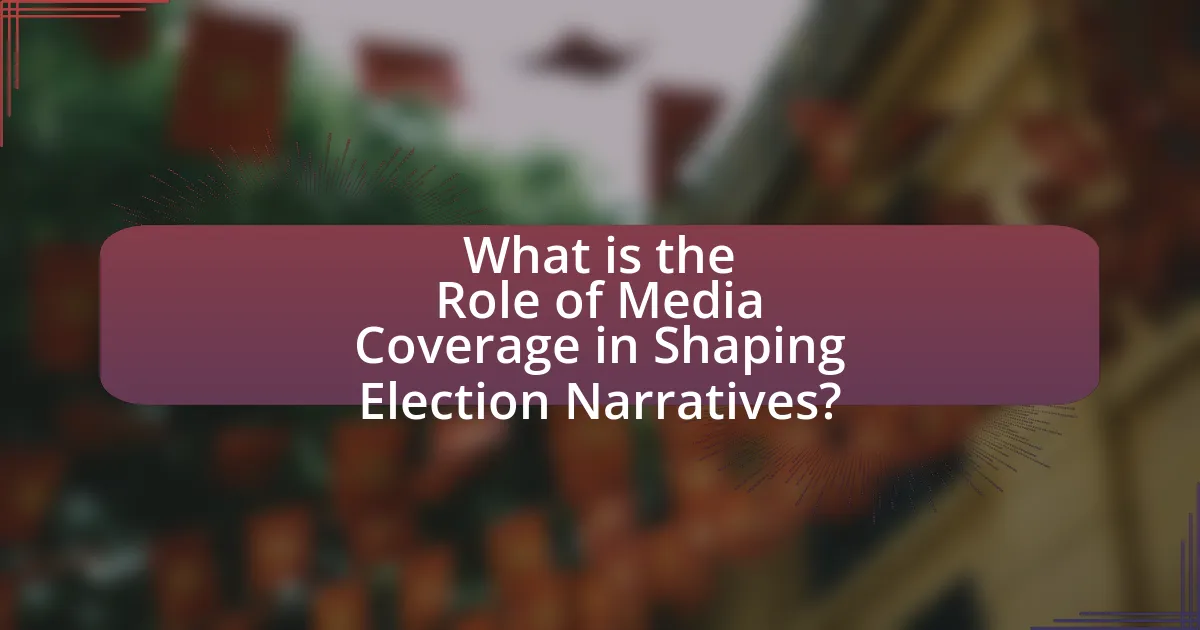
What is the Role of Media Coverage in Shaping Election Narratives?
Media coverage plays a crucial role in shaping election narratives by influencing public perception and framing political discourse. Through selective reporting, media outlets highlight specific issues, candidates, and events, which can sway voter opinions and priorities. For instance, studies have shown that the tone and frequency of coverage can significantly impact a candidate’s favorability ratings; a 2016 study by the Pew Research Center found that candidates receiving more positive media coverage were more likely to gain support among undecided voters. Additionally, media narratives can create a sense of urgency or importance around particular topics, guiding the public agenda and affecting voter turnout. Thus, the way media presents information directly affects the electoral landscape and voter behavior.
How does media coverage influence public perception during elections?
Media coverage significantly influences public perception during elections by shaping narratives, framing candidates, and highlighting specific issues. The way media outlets report on candidates can create biases, either positively or negatively, affecting voter opinions. For instance, studies have shown that candidates receiving more favorable media coverage tend to experience higher polling numbers, as seen in the 2008 U.S. presidential election, where Barack Obama’s extensive media presence contributed to his popularity. Furthermore, the framing of issues, such as the economy or healthcare, can direct public attention and concern, ultimately influencing voter priorities and decisions.
What are the key elements of media coverage that impact election narratives?
The key elements of media coverage that impact election narratives include framing, agenda-setting, and the portrayal of candidates. Framing refers to how media presents issues and events, influencing public perception and interpretation. For example, a study by Entman (1993) highlights that framing can shape the way voters understand political issues, thereby affecting their opinions and decisions. Agenda-setting involves the media’s ability to prioritize certain topics over others, which can lead to increased public awareness and concern about specific issues, as demonstrated by McCombs and Shaw (1972) in their research on the 1968 presidential election. Lastly, the portrayal of candidates, including their character, competence, and policies, significantly affects voter perceptions, as shown in various analyses of media coverage during elections, which reveal that positive or negative portrayals can sway public opinion and voting behavior.
How do different media formats affect the portrayal of candidates?
Different media formats significantly influence the portrayal of candidates by shaping public perception through varying levels of engagement and presentation styles. For instance, television news often emphasizes visual appeal and sound bites, which can lead to a more superficial understanding of candidates, while print media allows for in-depth analysis and nuanced discussion of policies. Research by the Pew Research Center indicates that candidates who receive extensive coverage on social media platforms tend to have their messages amplified, impacting voter opinions more dynamically than traditional media. Furthermore, studies show that candidates portrayed positively in online formats can experience a 20% increase in favorability ratings, highlighting the powerful role of media formats in shaping electoral narratives.
Why is media coverage critical in the electoral process?
Media coverage is critical in the electoral process because it shapes public perception and informs voter decisions. The media acts as a primary source of information about candidates, policies, and electoral events, influencing how voters understand and engage with the political landscape. For instance, studies have shown that extensive media coverage can significantly impact voter turnout and candidate favorability, as seen in the 2008 U.S. presidential election where media exposure played a key role in Barack Obama’s campaign success. Furthermore, the framing of issues by the media can determine which topics are prioritized in public discourse, thereby affecting the electoral agenda.
What historical examples illustrate the impact of media on elections?
The impact of media on elections is exemplified by the 1960 U.S. presidential debate between John F. Kennedy and Richard Nixon. This debate marked the first time televised debates played a crucial role in shaping public perception. Kennedy’s confident and charismatic television presence contrasted sharply with Nixon’s less polished appearance, influencing viewers’ opinions and contributing to Kennedy’s eventual victory. Additionally, the Watergate scandal in the early 1970s showcased how investigative journalism could sway public opinion and lead to significant political consequences, ultimately resulting in Nixon’s resignation. These examples illustrate how media coverage can significantly affect electoral outcomes by shaping narratives and influencing voter perceptions.
How does media coverage contribute to voter engagement and turnout?
Media coverage significantly enhances voter engagement and turnout by informing the public about candidates, issues, and the electoral process. When media outlets provide comprehensive coverage, they increase awareness and understanding of the political landscape, which motivates individuals to participate in elections. For instance, studies have shown that increased media exposure correlates with higher voter turnout; the U.S. Census Bureau reported that in the 2020 election, 66.8% of eligible voters participated, partly due to extensive media coverage that highlighted the importance of voting amid the COVID-19 pandemic. Furthermore, media coverage can shape public opinion and create a sense of urgency around elections, encouraging citizens to engage actively in the democratic process.
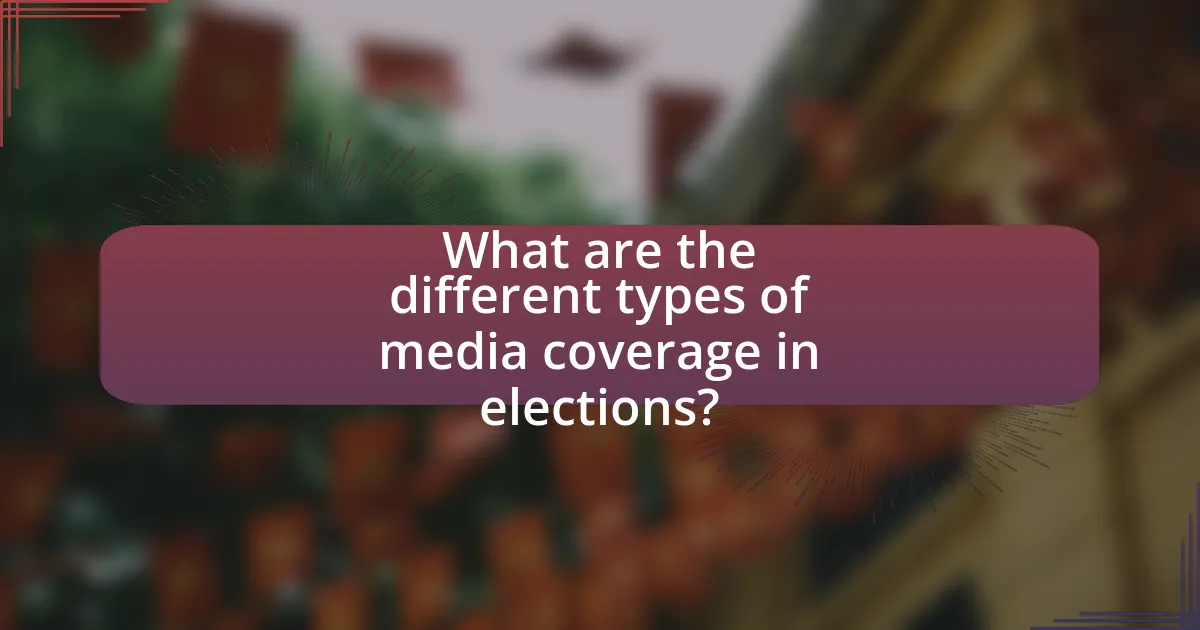
What are the different types of media coverage in elections?
The different types of media coverage in elections include news reporting, opinion pieces, debates, advertisements, and social media engagement. News reporting provides factual information about candidates and issues, while opinion pieces offer editorial perspectives that can influence public perception. Debates are structured discussions that allow candidates to present their views directly to voters, and advertisements are paid promotions that highlight specific messages or attributes of candidates. Social media engagement facilitates direct interaction between candidates and voters, shaping narratives in real-time. Each type of coverage plays a crucial role in informing voters and influencing election outcomes.
How do traditional media and digital media differ in their election coverage?
Traditional media and digital media differ significantly in their election coverage by the speed and interactivity of information dissemination. Traditional media, such as newspapers and television, typically provide in-depth analysis and curated content, often with a delay in reporting due to editorial processes. In contrast, digital media allows for real-time updates and immediate engagement through social media platforms, enabling users to interact with content and share their opinions instantly. For example, during the 2020 U.S. presidential election, platforms like Twitter and Facebook facilitated rapid information sharing, with millions of tweets and posts generated within minutes of key events, highlighting the immediacy of digital media compared to the slower pace of traditional outlets.
What role do newspapers and television play in shaping narratives?
Newspapers and television play a crucial role in shaping narratives by influencing public perception and framing issues. They serve as primary sources of information, guiding how events and topics are understood by the audience. For instance, during elections, newspapers often highlight specific candidates’ policies and controversies, while television news can emphasize visual storytelling, impacting voter opinions and engagement. Research indicates that media framing can significantly affect public attitudes; a study by Iyengar and Kinder (1987) demonstrated that different news frames can lead to varying interpretations of the same event, thus shaping the overall narrative.
How has social media transformed election coverage?
Social media has transformed election coverage by enabling real-time communication and direct engagement between candidates and voters. This shift allows candidates to bypass traditional media filters, disseminating their messages directly to the public, which was notably evident during the 2008 U.S. presidential election when Barack Obama effectively utilized platforms like Facebook and Twitter to mobilize support and engage younger voters. Additionally, social media facilitates the rapid spread of information, including news, opinions, and campaign updates, significantly influencing public perception and voter behavior. According to a Pew Research Center study, 69% of adults reported using social media for political news in 2020, highlighting its critical role in shaping election narratives.
What are the potential biases in media coverage of elections?
Potential biases in media coverage of elections include partisan bias, framing bias, and selection bias. Partisan bias occurs when media outlets favor one political party or candidate over others, influencing public perception and voter behavior. For instance, a study by the Pew Research Center found that 62% of Americans believe news organizations favor one side in political reporting. Framing bias involves presenting information in a way that highlights certain aspects while downplaying others, which can shape how audiences interpret events. An example is how different outlets may emphasize economic issues over social issues depending on their editorial stance. Selection bias refers to the tendency of media to cover certain candidates or issues while ignoring others, leading to an incomplete narrative. Research by the American Press Institute indicates that coverage often disproportionately favors front-runners, which can skew public understanding of the electoral landscape.
How do ownership and funding sources influence media narratives?
Ownership and funding sources significantly influence media narratives by shaping the editorial direction and content priorities of media outlets. For instance, media companies owned by large corporations may prioritize narratives that align with their owners’ business interests or political affiliations, leading to biased reporting. A study by the Pew Research Center found that 70% of Americans believe that media ownership affects the news coverage they receive, indicating a widespread perception of bias linked to ownership. Furthermore, funding from specific interest groups or advertisers can lead to selective coverage, where stories that do not align with the funders’ agendas are underreported or ignored. This dynamic can skew public perception and influence electoral outcomes, as seen in the coverage disparities during the 2016 U.S. presidential election, where certain candidates received disproportionately favorable or unfavorable coverage based on the media outlets’ affiliations.
What are the implications of biased reporting on public opinion?
Biased reporting significantly distorts public opinion by shaping perceptions and influencing beliefs based on selective information. This distortion can lead to polarization, where individuals align more closely with the biased narratives presented, often disregarding opposing viewpoints. For instance, a study by the Pew Research Center found that individuals exposed to partisan news sources are more likely to adopt extreme political views, illustrating how biased reporting can create echo chambers that reinforce existing biases. Additionally, biased reporting can undermine trust in media institutions, as audiences may perceive news as unreliable or manipulative, further complicating the public’s ability to make informed decisions.
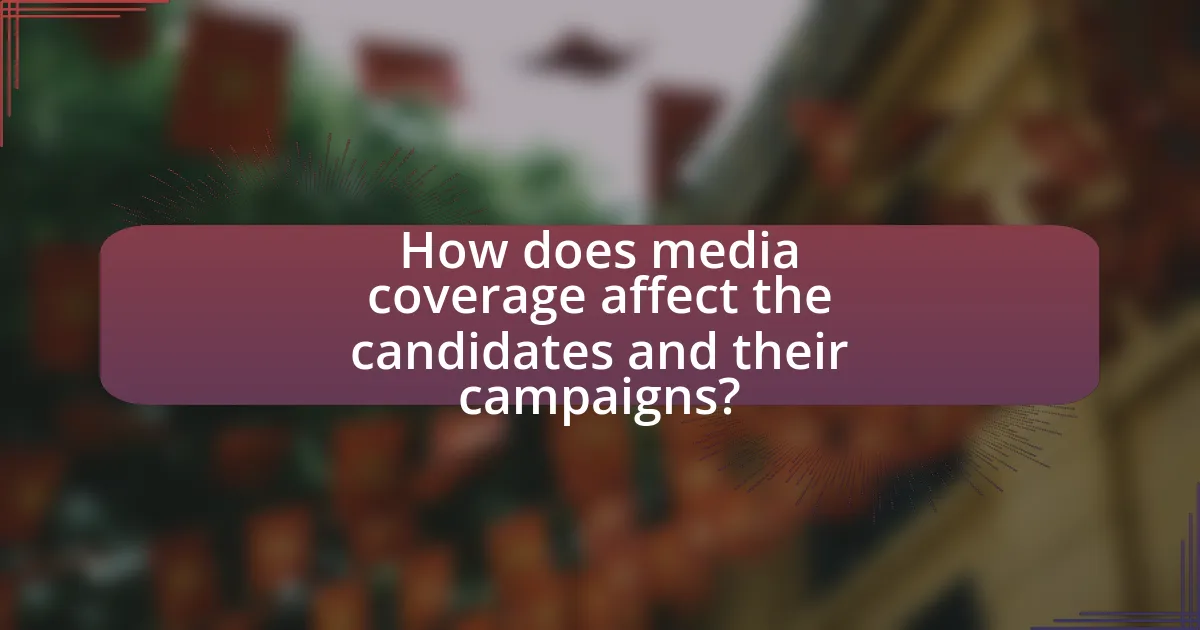
How does media coverage affect the candidates and their campaigns?
Media coverage significantly influences candidates and their campaigns by shaping public perception and voter behavior. Positive media coverage can enhance a candidate’s image, increase their visibility, and boost their chances of winning, as evidenced by studies showing that candidates receiving favorable press often experience higher polling numbers. Conversely, negative media coverage can damage a candidate’s reputation, leading to decreased support and potential voter backlash. For instance, during the 2016 U.S. presidential election, extensive media scrutiny of candidates’ controversies directly impacted their campaign dynamics and public opinion. Thus, the nature and tone of media coverage play a crucial role in determining the success or failure of political campaigns.
What strategies do candidates use to leverage media coverage?
Candidates use several strategies to leverage media coverage effectively. They often engage in proactive communication by issuing press releases and organizing press conferences to control the narrative surrounding their campaigns. Additionally, candidates utilize social media platforms to amplify their messages and reach a broader audience, as evidenced by the significant role social media played in the 2020 U.S. presidential election, where candidates like Joe Biden and Donald Trump effectively used platforms like Twitter and Facebook to shape public perception. Furthermore, candidates often participate in interviews and debates, which provide opportunities to showcase their policies and counter opponents’ narratives directly. These strategies collectively enhance visibility and influence public opinion, demonstrating the critical role of media in shaping election narratives.
How do candidates respond to negative media coverage?
Candidates typically respond to negative media coverage by issuing public statements to refute claims, engaging in damage control through social media, and sometimes holding press conferences to clarify their positions. For instance, during the 2016 U.S. presidential election, candidates like Hillary Clinton and Donald Trump frequently addressed negative stories by directly countering the narratives presented in the media, often using platforms like Twitter to communicate their rebuttals instantly. This strategy aims to mitigate the impact of negative coverage on public perception and maintain voter support.
What role does media training play in a candidate’s campaign?
Media training plays a crucial role in a candidate’s campaign by equipping them with the skills to effectively communicate their message and manage public perception. This training helps candidates prepare for interviews, debates, and public appearances, ensuring they can articulate their policies clearly and confidently. Research indicates that candidates who undergo media training are more likely to present themselves positively, which can significantly influence voter perception and engagement. For instance, a study by the Pew Research Center found that effective communication strategies can enhance a candidate’s favorability ratings by up to 20%. Thus, media training is essential for candidates to navigate the complexities of media interactions and shape their electoral narratives effectively.
How do media narratives shape the issues discussed during elections?
Media narratives significantly shape the issues discussed during elections by framing the political discourse and influencing public perception. For instance, the way media outlets prioritize certain topics, such as healthcare or immigration, can elevate these issues in the minds of voters, leading to a focus on them during campaigns. Research by the Pew Research Center indicates that media coverage can determine which issues are seen as most important, as voters often rely on news sources to inform their opinions. Furthermore, the portrayal of candidates and their positions can create biases that affect voter attitudes and decisions, as evidenced by studies showing that negative coverage can diminish a candidate’s support. Thus, media narratives play a crucial role in shaping electoral issues and influencing the overall political landscape.
What are the most common issues highlighted by media coverage?
The most common issues highlighted by media coverage include political corruption, economic inequality, healthcare access, and climate change. These topics frequently dominate news cycles, reflecting public concern and influencing voter perceptions. For instance, a 2020 Pew Research Center study found that 63% of Americans viewed political corruption as a significant issue, while 54% expressed concern over economic inequality. Such statistics demonstrate how media coverage shapes the narrative around these pressing issues, ultimately impacting electoral outcomes.
How do media narratives influence the political agenda?
Media narratives significantly influence the political agenda by shaping public perception and prioritizing specific issues. When media outlets focus on particular topics, they elevate those issues in the public consciousness, prompting political actors to respond or adapt their agendas accordingly. For instance, during the 2016 U.S. presidential election, extensive media coverage of immigration issues led candidates to prioritize immigration reform in their platforms, demonstrating how media attention can dictate political focus. Studies, such as the one conducted by the Pew Research Center, show that media framing can affect public opinion and voter behavior, further validating the impact of media narratives on political agendas.

What are the best practices for understanding media coverage in elections?
To understand media coverage in elections effectively, one should critically analyze the sources of information, assess the framing of issues, and recognize potential biases. Evaluating the credibility of media outlets is essential, as studies show that partisan media can significantly influence public perception and voter behavior. For instance, research by the Pew Research Center indicates that individuals who consume news from ideologically aligned sources are more likely to hold polarized views. Additionally, examining how different media outlets frame candidates and issues can reveal underlying biases; for example, the use of language and imagery can shape voter attitudes. Engaging with a variety of media sources, including independent and international outlets, can provide a more balanced perspective and mitigate the effects of bias.
How can voters critically evaluate media coverage of elections?
Voters can critically evaluate media coverage of elections by analyzing the sources, checking for bias, and comparing multiple outlets. By identifying the credibility of sources, such as established news organizations versus opinion-based platforms, voters can discern the reliability of the information presented. Furthermore, recognizing bias involves assessing language, framing, and the selection of stories that may favor one candidate or party over another. Research indicates that media framing can significantly influence public perception, as shown in studies like “The Effects of News Coverage on Public Opinion” by the Pew Research Center, which highlights how different narratives can shape voter attitudes. Lastly, comparing coverage from various media outlets allows voters to gain a more balanced perspective, ensuring they are informed by diverse viewpoints rather than a singular narrative.
What tools and resources are available for analyzing media bias?
Tools and resources available for analyzing media bias include Media Bias/Fact Check, AllSides, and Ad Fontes Media. Media Bias/Fact Check provides a comprehensive database that rates the bias of various news outlets based on their reporting patterns and factual accuracy. AllSides offers a platform that presents news stories from multiple perspectives, allowing users to compare how different outlets cover the same events. Ad Fontes Media uses a systematic approach to evaluate the bias and reliability of news sources, categorizing them on a spectrum from left to right. These resources are widely recognized for their methodologies and are frequently cited in academic and journalistic contexts for assessing media bias.
How can voters differentiate between factual reporting and opinion pieces?
Voters can differentiate between factual reporting and opinion pieces by examining the language and structure of the content. Factual reporting typically presents verifiable information, such as statistics, quotes from credible sources, and objective descriptions of events, while opinion pieces express personal viewpoints, often using subjective language and persuasive techniques. For example, a news article might report on election results with specific numbers and direct quotes from officials, whereas an opinion piece might argue about the implications of those results without providing objective evidence. This distinction is crucial for voters to make informed decisions based on reliable information rather than personal biases.
What tips can help voters navigate media narratives during elections?
Voters can navigate media narratives during elections by critically evaluating sources, seeking diverse perspectives, and verifying information. Critical evaluation involves assessing the credibility of news outlets, as studies show that reputable sources are more likely to provide accurate reporting. Seeking diverse perspectives helps voters understand different viewpoints, reducing the risk of confirmation bias, which can skew perceptions of candidates and issues. Verifying information through fact-checking organizations, such as PolitiFact or FactCheck.org, ensures that voters are informed by accurate data rather than misinformation, which has been shown to proliferate during election cycles.
How can voters stay informed without being misled by media coverage?
Voters can stay informed without being misled by media coverage by diversifying their news sources and critically evaluating the information presented. Engaging with multiple reputable outlets, including independent and international news organizations, helps to provide a broader perspective and reduces the risk of bias. Research indicates that individuals who consume news from a variety of sources are less likely to fall victim to misinformation, as they can cross-reference facts and viewpoints. For instance, a study by the Pew Research Center found that people who follow news from different platforms are better equipped to identify false information. Additionally, voters should seek out fact-checking websites and tools that assess the accuracy of claims made in the media, further enhancing their ability to discern credible information.
What role does fact-checking play in understanding election narratives?
Fact-checking plays a crucial role in understanding election narratives by verifying the accuracy of claims made by candidates and media outlets. This verification process helps to clarify misinformation and provides voters with reliable information, which is essential for informed decision-making. For instance, during the 2020 U.S. presidential election, organizations like FactCheck.org and PolitiFact documented and corrected numerous false statements, influencing public perception and discourse. By holding politicians accountable and promoting transparency, fact-checking enhances the integrity of the electoral process and fosters a more informed electorate.

